
So you want to master sales, win new customers, and achieve your sales targets? You are at the right place. Let us share our picks on some of the best books to read for sales enthusiasts and key takeaways from these books.
In the world of salesmanship, literature stands as the guiding light for ambitious salespeople seeking to master their craft. Let’s embark on a riveting exploration through the corridors of these masterpieces, each akin to a seasoned mentor, enriching us with profound insights and strategies.
1. “SPIN Selling” by Neil Rackham
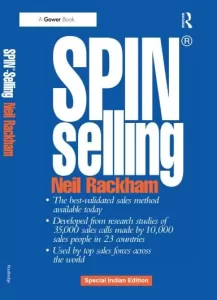
Neil Rackham’s magnum opus, “SPIN Selling,” unveils the artistry behind the acronym—Situation, Problem, Implication, Need-Payoff. It’s an exquisite journey, meticulously detailing the nuanced approach to questioning, unearthing customer needs, and orchestrating the symphony of closure.
Read more reviews and buy it now from Amazon link below:
Key Takeaways:
- Situation Questions: Start by understanding the customer’s current situation. These questions gather basic information about the customer’s business, environment, and existing processes.
- Problem Questions: Dive into the customer’s challenges and pain points. Identify specific problems or difficulties they are facing. This helps create a foundation for demonstrating how your product or service can address their needs.
- Implication Questions: Explore the consequences and impact of the identified problems. By understanding the implications, you can emphasize the urgency and importance of solving these issues, making your solution more compelling.
- Need-payoff Questions: Shift the focus to the positive outcomes and benefits of your solution. Encourage the customer to envision how your product or service can alleviate their problems and contribute to their success.
In essence, “SPIN Selling” encourages a consultative approach, where the salesperson becomes a problem-solver. By guiding the conversation through these four types of questions, the seller can build a comprehensive understanding of the customer’s needs and tailor their pitch to offer a solution that genuinely addresses those needs.
Remember, effective selling is not just about pushing a product but understanding the customer’s perspective and demonstrating how your offering adds value to their specific situation.
2. “To Sell Is Human: The Surprising Truth About Moving Others” by Daniel H. Pink
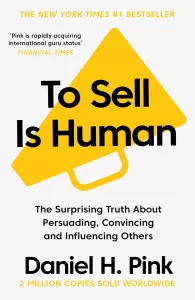
In a paradigm-shifting revelation, Daniel Pink elevates the canvas, portraying salesmanship not as an occupation but as a universal vocation. This opus illuminates the dynamics of persuasion and influence, transcending professions and fostering a profound understanding of human interaction.
Buy it now from the Amazon link below:
Key Takeaways:
- Everyone is in Sales: Pink argues that regardless of our profession, we are all in the business of selling. Whether we are selling products, ideas, or ourselves, the ability to move others is a fundamental skill for success in the modern world.
- The ABCs of Selling: Pink introduces a new ABC model – Attunement, Buoyancy, and Clarity.
- Attunement: The ability to understand and connect with others, tuning into their perspectives and needs.
- Buoyancy: The resilience and positivity to navigate through rejection and challenges inherent in sales.
- Clarity: The capacity to distill complex ideas into clear, understandable messages, making it easier for others to grasp and accept.
- Serve, Don’t Sell: Pink emphasizes the importance of serving others rather than just selling to them. By focusing on the needs and interests of others, we build trust and establish long-term relationships.
- The Pixar Pitch: Pink introduces a method inspired by Pixar’s storytelling approach. It involves crafting a pitch by addressing three questions – What is your idea? Why does it matter? What’s the next step?
“To Sell Is Human” redefines the concept of selling, emphasizing the human and relational aspects of persuasion. Pink’s insights encourage a more empathetic and service-oriented approach to influence and convince others, ultimately leading to more meaningful connections and successful interactions.
3. “Influence: The Psychology of Persuasion” by Robert B. Cialdini
Robert Cialdini’s masterpiece transcends mere salesmanship, delving into the intricate tapestry of human psychology. Here lies a compendium of ethical influence, deciphering the six principles that orchestrate the symphony of persuasion.
Buy it now from the Amazon link below:
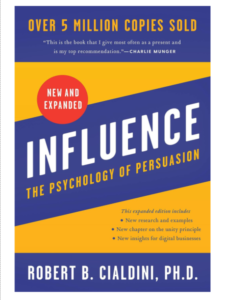
Key Takeaways:
- Six Universal Principles of Influence:
- Reciprocity: People feel compelled to return favors. By providing value or assistance, you can trigger a sense of obligation in others.
- Commitment and Consistency: Once people commit to a small action or belief, they are more likely to follow through with larger commitments that align with that initial decision.
- Social Proof: People tend to follow the actions of others, especially in uncertain situations. Demonstrating that others have chosen a particular option can influence decision-making.
- Authority: People are more likely to comply with requests from those perceived as authorities or experts in a given domain.
- Liking: People prefer to say “yes” to those they know and like. Building rapport and finding common ground can enhance persuasiveness.
- Scarcity: The idea that something is more desirable when it is perceived as scarce or in limited supply. Creating a sense of urgency can drive action.
- Weapons of Influence: Cialdini introduces the concept of “weapons of influence,” referring to the tactics that leverage these principles to persuade others more effectively.
- Understanding and Resisting Influence: The book also delves into how individuals can be aware of and resist manipulative persuasion attempts by recognizing these principles in action.
“Influence” provides valuable insights into the psychology of persuasion and offers practical strategies for individuals to navigate the influence process ethically. By understanding these universal principles, one can both become a more effective influencer and be better equipped to recognize and resist unwarranted persuasion attempts.
4. “The Challenger Sale: Taking Control of the Customer Conversation” by Matthew Dixon and Brent Adamson
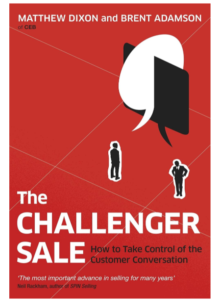
Matthew Dixon and Brent Adamson unfurl the paradigm of the “Challenger Salesperson.” This opus is a trove of transformative insights, advocating a proactive approach in moulding customer conversations, thereby steering the narrative toward a triumphant outcome.
Buy it now from the Amazon link below:
Key Takeaways:
- The Challenger Profile:
- The authors identify a successful salesperson as a “Challenger” who takes control of customer conversations.
- Challengers educate customers, challenging their preconceptions and pushing them to reconsider their needs.
- Teaching for Differentiation:
- Instead of just responding to customer inquiries, Challengers actively teach and tailor their messages to demonstrate a deep understanding of the customer’s business and industry.
- They provide insights that customers may not have considered, differentiating themselves and their offerings.
- Tailoring for Resonance:
- Challengers tailor their sales message to resonate with the specific challenges and goals of each customer.
- This personalized approach helps create a more meaningful connection with the customer.
- Taking Control of the Sale:
- Challengers take control of the sales process by leading with insights, challenging the status quo, and guiding the customer towards a solution that aligns with their unique needs.
- Team Collaboration:
- The book emphasizes the importance of collaboration within the sales team, encouraging a collective effort to share insights and strategies for challenging and influencing customers effectively.
“The Challenger Sale” advocates a proactive, insightful, and challenging approach to selling. It suggests that successful salespeople aren’t just responsive to customer needs but actively lead conversations by providing valuable insights that reshape how customers view their problems and potential solutions. The book encourages sales professionals to become Challengers who teach, tailor, and take control of customer interactions for more effective and impactful results.
5. “Fanatical Prospecting” by Jeb Blount
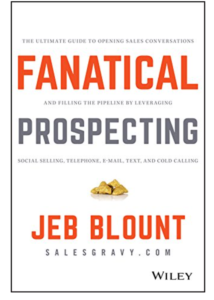
Jeb Blount’s treatise delves deep into the bedrock of sustainable sales—prospecting. It meticulously stitches together the fabric of relentless pursuit, unveiling actionable strategies to fortify the sales pipeline with a steady influx of potential clientele.
Buy it now from the Amazon link below:
Key Takeaways:
- The Importance of Prospecting:
- Blount stresses the significance of proactive prospecting for sales success, arguing that it is the lifeblood of a thriving sales career.
- Consistent prospecting helps maintain a healthy pipeline and ensures a steady flow of potential opportunities.
- The Rule of 30:
- The author introduces the Rule of 30, suggesting that sales professionals should aim to engage in at least 30 minutes of focused prospecting every day to build momentum and generate results.
- Effective Prospecting Methods:
- Blount discusses various prospecting methods, including phone calls, emails, social selling, and networking.
- The book provides insights into crafting compelling messages and utilizing different channels to reach and engage with prospects.
- Overcoming Rejection:
- Recognizing that rejection is part of the prospecting process, the book offers strategies and mindset shifts to handle rejection positively and persistently.
- Time Management:
- “Fanatical Prospecting” emphasizes the importance of disciplined time management to allocate dedicated periods for prospecting activities amidst other responsibilities.
- Building a Prospecting Cadence:
- Blount suggests creating a structured and systematic prospecting cadence that includes a mix of outreach methods to maximize effectiveness.
In essence, “Fanatical Prospecting” advocates for a proactive and disciplined approach to generating new business opportunities. The book provides practical strategies, tools, and mindset shifts to help sales professionals overcome common challenges associated with prospecting, ultimately enabling them to build a robust pipeline and achieve long-term success in sales.
6. “How to Win Friends and Influence People” by Dale Carnegie
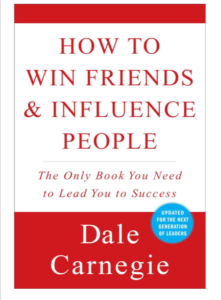
Though not bound by the confines of a sales tome, Dale Carnegie’s timeless masterpiece resonates profoundly within the sales fraternity. It extols the virtues of relationship building, an indispensable cornerstone in the edifice of successful salesmanship.
Buy it now from the Amazon link below:
Key Takeaways:
- Show Genuine Interest:
- Carnegie emphasizes the importance of showing genuine interest in others. Actively listen, ask questions, and demonstrate that you care about the concerns and interests of those around you.
- The Power of a Smile:
- A simple smile can have a profound impact. It creates a positive atmosphere and makes you more approachable.
- Remember Names:
- People appreciate being recognized and remembered. Make an effort to remember and use the names of those you interact with.
- Avoid Criticism and Condemnation:
- Carnegie suggests avoiding criticism and condemnation, as they can create a negative atmosphere. Instead, provide constructive feedback and focus on finding solutions.
- Encourage Others to Talk About Themselves:
- People enjoy talking about themselves. Encourage others to share their thoughts and experiences, and show genuine interest in what they have to say.
- Acknowledge Mistakes Gracefully:
- When you make a mistake, acknowledge it gracefully. Admitting faults can strengthen relationships and build trust.
- Inspire Enthusiasm in Others:
- Foster enthusiasm in others by expressing genuine enthusiasm yourself. Show appreciation and encourage positive attitudes.
- See Things from Others’ Perspectives:
- Understanding others’ viewpoints is crucial for effective communication. Empathize with their feelings and consider their perspectives.
- Make Others Feel Important:
- Carnegie stresses the importance of making others feel valued and important. Acknowledge their contributions and give credit where it’s due.
- Win People to Your Way of Thinking:
- Instead of imposing your ideas, find common ground and present your thoughts in a way that aligns with the interests and perspectives of others.
“How to Win Friends and Influence People” provides timeless principles for building positive and meaningful relationships. By incorporating these principles into daily interactions, individuals can enhance their social skills, foster goodwill, and ultimately influence others positively and constructively.
7. “Predictable Revenue: Turn Your Business Into a Sales Machine with the $100 Million Best Practices of Salesforce.com” by Aaron Ross and Marylou Tyler
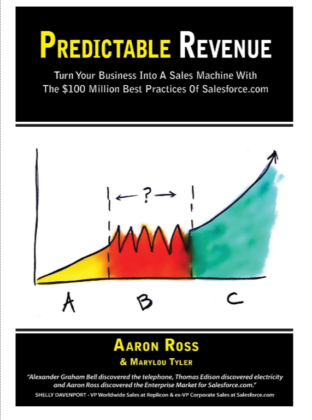
Ross and Tyler’s opus is a compendium of strategies derived from Salesforce.com’s meteoric ascent. It unveils the alchemy of predictable revenue growth, proffering insights to cultivate and expand a triumphant sales force.
Buy it now from the Amazon link below:
Key Takeaways:
- Specialization of Roles:
- The authors advocate for the specialization of sales roles, with distinct teams handling prospecting, closing deals, and post-sales activities. This allows each team to focus on their expertise, leading to more efficient and effective processes.
- Outbound Prospecting:
- Introducing the concept of outbound prospecting, the book emphasizes the importance of proactively reaching out to potential customers instead of relying solely on inbound leads.
- Cold Calling 2.0:
- Ross introduces the idea of “Cold Calling 2.0,” which involves a strategic and systematic approach to outbound prospecting. This method focuses on targeting specific niches, using email campaigns, and leveraging technology to streamline the prospecting process.
- Building Predictable Revenue Streams:
- The book provides a framework for building predictable and scalable revenue streams by implementing outbound prospecting as a consistent and measurable process.
- Salesforce.com Case Study:
- The authors draw on their experience at Salesforce.com, showcasing how the company achieved significant revenue growth by implementing the strategies outlined in the book.
- Lead Qualification and Nurturing:
- “Predictable Revenue” emphasizes the importance of lead qualification and nurturing to ensure that only high-quality leads are passed on to the sales team, maximizing their efficiency.
- Creating a Sales Machine:
- By implementing the recommended strategies, businesses can transform their sales processes into a well-oiled machine that consistently generates predictable revenue.
In summary, “Predictable Revenue” provides a systematic and actionable approach to building a predictable and scalable revenue-generating engine. The book’s insights into outbound prospecting, specialization of roles, and the case study from Salesforce.com offer practical strategies for businesses looking to optimize their sales processes and achieve sustainable growth.
8. “Pitch Anything: An Innovative Method for Presenting, Persuading, and Winning the Deal” by Oren Klaff
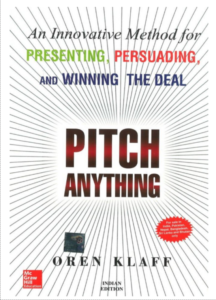
Oren Klaff’s opulent exposition crafts a novel approach to the art of pitching. It magnificently intertwines the essence of framing, status, and narrative architecture, endowing the adept salesperson with the prowess to captivate and conquer.
Buy it now from the Amazon link below:
Key Takeaways:
- Frame Control:
- Klaff emphasizes the concept of “Frame Control,” the ability to set the context and control the perception of the pitch. Maintaining a strong frame allows the presenter to guide the audience’s interpretation of the information.
- The Three-Act Structure:
- The book introduces a three-act structure for effective pitches: Setting the Frame, Telling the Story, and Revealing the Intrigue. This structure helps create a compelling narrative that captures and maintains the audience’s attention.
- Hot Cognitions:
- Klaff introduces the concept of “Hot Cognitions,” which are emotional triggers that engage the audience on a visceral level. Incorporating elements that evoke emotion helps make the pitch more memorable and persuasive.
- Status Plays:
- The author discusses the importance of establishing and maintaining high social status during a pitch. Demonstrating confidence, authority, and expertise enhances the presenter’s credibility and influence.
- Creating Scarcity and Urgency:
- Klaff explores the psychological impact of scarcity and urgency in a pitch. Creating a sense of limited availability or a time-sensitive opportunity can increase the perceived value of the proposition.
- Anchoring:
- The book introduces the concept of “Anchoring,” where the presenter strategically sets a reference point that influences the audience’s perception of value. This can be a powerful tool for negotiating favorable terms.
- Managing Power Dynamics:
- Klaff provides insights into understanding and navigating power dynamics during pitches, including strategies for handling objections and maintaining control in challenging situations.
“Pitch Anything” offers a fresh perspective on the art of pitching by integrating principles of psychology, storytelling, and strategic communication. The book’s focus on Frame Control, emotional engagement, and status plays provides a comprehensive guide for presenters looking to captivate their audience, make memorable pitches, and increase their chances of winning deals.
9. “The Sales Acceleration Formula: Using Data, Technology, and Inbound Selling to Go from $0 to $100 Million” by Mark Roberge
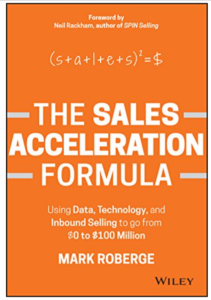
Mark Roberge, through his opus, unravels a meticulously orchestrated symphony of data-driven sales prowess. This narrative is a beacon, illuminating the path to fostering and nurturing a high-performance sales team.
Buy it now from the Amazon link below:
Key Takeaways:
- Inbound Selling Methodology:
- The book emphasizes the importance of inbound selling, where businesses attract and engage potential customers through valuable content and a strong online presence.
- The Sales Hiring Formula:
- Roberge introduces a data-driven approach to hiring salespeople, focusing on specific characteristics and skills that align with the company’s culture and sales strategy.
- Training and Onboarding:
- The author discusses the significance of a structured training and onboarding process for sales teams. This ensures that new hires quickly become productive and align with the company’s sales methodology.
- Sales Process and Technology:
- Roberge outlines the development of a scalable and repeatable sales process that leverages technology for efficiency. This includes the use of customer relationship management (CRM) tools and analytics to track and optimize sales performance.
- Data-Driven Decision-Making:
- The book advocates for a data-driven approach to decision-making in sales. By analyzing key performance indicators (KPIs) and leveraging metrics, businesses can continuously refine and improve their sales strategies.
- Sales and Marketing Alignment:
- Roberge emphasizes the importance of alignment between sales and marketing teams. A cohesive strategy ensures a seamless transition of leads from marketing to sales, improving overall conversion rates.
- Customer Success Integration:
- The author introduces the concept of integrating customer success into the sales process. Ensuring customer satisfaction and retention becomes a key part of the overall growth strategy.
- Experimentation and Continuous Improvement:
- The book encourages a culture of experimentation and continuous improvement. By testing and iterating on various strategies, businesses can identify what works best for their unique context and market.
“The Sales Acceleration Formula” provides a comprehensive framework for organizations looking to scale their sales operations from startup to a $100 million level. The book’s focus on inbound selling, data-driven decision-making, and the integration of technology offers practical insights for businesses seeking to accelerate their sales growth systematically and sustainably.
10. “The Psychology of Selling” by Brian Tracy
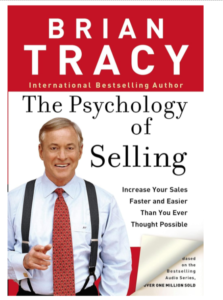
Brian Tracy’s oeuvre orchestrates a melange of psychological nuances that choreograph the ballet of buying decisions. It offers an arsenal of techniques and strategies, akin to a maestro’s baton, directing the sales performance crescendo.
Buy it now from the Amazon link below:
Key Takeaways:
- Positive Mindset:
- Tracy emphasizes the importance of maintaining a positive mindset in sales. A confident and optimistic attitude can significantly impact the way potential customers perceive you and your offerings.
- Understanding Buyer Psychology:
- The book explores the psychological factors that influence buyers, such as emotions, desires, and decision-making processes. Understanding these elements allows sales professionals to tailor their approach effectively.
- Building Trust and Credibility:
- Tracy discusses the significance of building trust and credibility with customers. Establishing a strong rapport and being perceived as a trustworthy expert can positively impact the sales relationship.
- Effective Communication:
- The book provides practical tips for effective communication, including active listening, asking probing questions, and using persuasive language to articulate the value proposition.
- Handling Objections:
- Tracy offers strategies for handling objections gracefully. Instead of viewing objections as obstacles, the book suggests reframing them as opportunities to provide additional information and address concerns.
- Closing Techniques:
- The author explores various closing techniques, providing practical insights into how to ask for the sale confidently. Closing is presented as a natural progression of the sales conversation.
- Goal Setting and Planning:
- “The Psychology of Selling” stresses the importance of setting clear sales goals and developing actionable plans to achieve them. Goal setting helps maintain focus and motivation in the competitive sales environment.
- Time Management:
- Tracy discusses the significance of effective time management in sales. Prioritizing tasks, minimizing distractions, and focusing on high-impact activities contribute to increased productivity.
- Continuous Learning:
- The book encourages a mindset of continuous learning and improvement. Staying updated on industry trends, product knowledge, and sales techniques is crucial for staying competitive in the market.
In summary, “The Psychology of Selling” provides a comprehensive exploration of the psychological aspects that influence successful selling. From mindset and communication to handling objections and closing, Brian Tracy offers practical guidance for sales professionals looking to enhance their effectiveness and achieve greater success in their roles.
11. “Never Split the Difference: Negotiating As If Your Life Depended On It” by Chris Voss
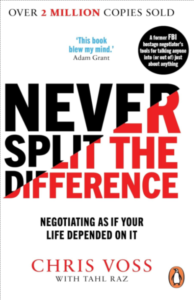
Chris Voss, akin to a maestro in the negotiation symphony, unveils an enthralling saga. His narrative transcends conventional sales parlance, ushering in a realm of high-stakes negotiation strategies derived from his tenure as an FBI hostage negotiator.
Buy it now from the Amazon link below:
Key Takeaways:
- Emotional Intelligence in Negotiation:
- Voss highlights the importance of emotional intelligence in negotiation. Understanding and acknowledging the emotions of both parties can lead to more successful outcomes.
- The Power of Mirroring:
- Mirroring involves repeating the last few words of what the other person said. This simple technique can create a connection and encourage the counterpart to share more information.
- Labeling and Validating Emotions:
- Labeling involves naming the emotions the other party is experiencing. Validating these emotions demonstrates empathy and helps in building rapport.
- The Accusation Audit:
- Anticipating and addressing potential objections or concerns before they arise is termed as the “Accusation Audit.” Proactively acknowledging issues fosters trust and allows for smoother negotiations.
- Calibrated Questions:
- Voss introduces the concept of calibrated questions—open-ended questions that begin with “what” or “how.” These questions encourage the counterpart to share information and provide insights into their perspective.
- Tactical Empathy:
- The book advocates for “tactical empathy,” a balanced approach that combines understanding the other person’s perspective with achieving your objectives in the negotiation.
- The Importance of Silence:
- Voss emphasizes the power of silence in negotiation. Allowing silence after making a proposal or asking a question can prompt the other party to reveal more information or make concessions.
- Negotiating with the “Black Swan”:
- Black Swans are unexpected events that can significantly impact negotiations. Voss advises on being prepared for such surprises and adjusting strategies accordingly.
- The “No” Response:
- Instead of fearing the word “no,” Voss encourages negotiators to view it as the beginning of a negotiation. It opens the door for further exploration and compromise.
- Closing with Precision:
- The book provides insights into effective closing techniques, ensuring that the negotiated deal is clearly defined and agreed upon by both parties.
“Never Split the Difference” offers a unique perspective on negotiation by drawing from high-stakes hostage situations. By applying the principles of tactical communication, empathy, and active listening, negotiators can enhance their skills and achieve more favourable outcomes in a wide range of scenarios.
12. “Secrets of Closing the Sale” by Zig Ziglar
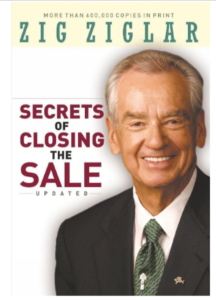
Zig Ziglar, the venerable sage of salesmanship, weaves an opulent tapestry in his discourse. His profound insights and practical techniques in sealing the deal emerge as a treasure trove for every aspiring sales virtuoso.
Buy it now from the Amazon link below:
Key Takeaways:
- Building Trust and Credibility:
- Ziglar emphasizes the importance of establishing trust and credibility with customers. A strong relationship is the foundation for successful sales.
- Understanding Customer Needs:
- The book advocates for thoroughly understanding the needs and desires of the customer. By asking probing questions and actively listening, sales professionals can tailor their pitch to address specific customer concerns.
- Features and Benefits:
- Ziglar introduces the concept of highlighting both the features and benefits of a product or service. While features provide information, it’s the benefits that resonate with customers and address their underlying motivations.
- The Puppy Dog Close:
- The “Puppy Dog Close” involves giving customers a taste or trial of the product, similar to taking a puppy home for a day. This technique allows customers to experience the value firsthand.
- Handling Objections:
- Ziglar provides strategies for effectively handling objections. Instead of viewing objections as roadblocks, sales professionals are encouraged to see them as opportunities to provide additional information and overcome concerns.
- Assumptive Closing:
- The book introduces the concept of assumptive closing, where the salesperson assumes that the customer has already decided to make the purchase. This mindset can lead to a more confident and persuasive presentation.
- Creating Urgency:
- Ziglar discusses the importance of creating a sense of urgency in the sales process. By highlighting time-sensitive benefits or limited-time offers, sales professionals can motivate customers to make decisions sooner.
- The “Now” Close:
- The “Now” close involves guiding customers to make immediate decisions. Ziglar provides techniques for encouraging customers to take action without unnecessary delays.
- Follow-Up and Relationship Building:
- The book emphasizes the significance of follow-up after the sale. Building long-term relationships with customers contributes to repeat business and referrals.
- The Professional Salesperson’s Code of Ethics:
- Ziglar underscores the importance of maintaining a high standard of ethics in sales. Trust and integrity are crucial for long-term success.
“Secrets of Closing the Sale” offers timeless principles for mastering the art of closing deals. Zig Ziglar’s focus on building relationships, understanding customer needs, and employing various closing techniques provides a comprehensive guide for sales professionals looking to enhance their effectiveness in the sales process.
In these amazing books about sales, you’ll find a bunch of really helpful tips and wisdom. Each book is like a guide, teaching you how to be great at sales. They’re like mentors, helping you get better and better. If you know of any more good books like these, let us know on social media! We’d love to hear your recommendations.
Author Profile

-
Team at Feel Good Now 24/7
Bringing you interesting feel-good content!






Any comments?